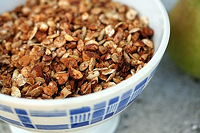 My wife and I enjoy healthy, homemade granola, and I like doing the cooking. When we run out, I make enough to keep us in stock for about 10 to 12 weeks. My favorite recipe calls for ingredients I invariably have in various stages of supply at any given time, so I usually have to run to the store for something but not everything. Once restocked, I follow the same procedure to make approximately four sets of 2 batches at a time until I’ve finished 8 batches in total. It takes 3 hours, so my planning has to evaluate not only my supply of ingredients, but also the availability of my oven, my mixing bowls, and my time for those 3 hours. It’s nice to have exclusive use of the kitchen during that time period, so I want to schedule around the other cooks in the kitchen. If you wanted to try some of my granola, I’d have to factor additional production into my planning. If you wanted to pay to try some of my granola, I might want to factor in my costs to make sure I wasn’t working for free. I probably would not want to actually get in that business, as I’d then have quality control and lot traceability issues. However, my granola sure is good and I think you’d like it!
My wife and I enjoy healthy, homemade granola, and I like doing the cooking. When we run out, I make enough to keep us in stock for about 10 to 12 weeks. My favorite recipe calls for ingredients I invariably have in various stages of supply at any given time, so I usually have to run to the store for something but not everything. Once restocked, I follow the same procedure to make approximately four sets of 2 batches at a time until I’ve finished 8 batches in total. It takes 3 hours, so my planning has to evaluate not only my supply of ingredients, but also the availability of my oven, my mixing bowls, and my time for those 3 hours. It’s nice to have exclusive use of the kitchen during that time period, so I want to schedule around the other cooks in the kitchen. If you wanted to try some of my granola, I’d have to factor additional production into my planning. If you wanted to pay to try some of my granola, I might want to factor in my costs to make sure I wasn’t working for free. I probably would not want to actually get in that business, as I’d then have quality control and lot traceability issues. However, my granola sure is good and I think you’d like it!
What does granola have to do with MRP and Shop Floor Control?
What is MRP?
 Manufacturing Resource Planning (MRP) software provides automation to account for every task listed above. I can easily imagine software helping with issues like inventory control, production planning, cost accounting, resource availability, quality control and lot traceability for my granola "manufacturing process". However, when my MRP consultant mentioned “shop floor control”, I might have to ask, “what is the definition of shop floor control?” So, let’s explore that in the context of my granola manufacturing example.
Manufacturing Resource Planning (MRP) software provides automation to account for every task listed above. I can easily imagine software helping with issues like inventory control, production planning, cost accounting, resource availability, quality control and lot traceability for my granola "manufacturing process". However, when my MRP consultant mentioned “shop floor control”, I might have to ask, “what is the definition of shop floor control?” So, let’s explore that in the context of my granola manufacturing example.
What is Shop Floor Control?
Shop Floor Control (SFC) manages the production activities, resources and materials after the production order is determined and released to the floor. Or, in granola speak, SFC keeps track of the effort and materials after I determine how much I want to make, and after I restock my cupboard. I update my SFC system for the amount of time it takes me to accomplish each task. I also enter how much time I use of the oven, the saucepan, and the other tools in my process. As I consume the oats and sliced almonds, I relate those to the batch and the equipment. If I drop a bowl on the floor and make a big mess, I enter the reason for that delay and the amount of time it took me to clean it up. Of course, I also have to enter my time to get ready to work and to clean up the kitchen afterwards. After I’m through, I have a complete picture of the amount of my time used on this cooking session, the wear and tear on my cooking utensils, and the decrease in my raw material supplies. Hopefully, my wife will let me buy a bar code scanner to cut down on data entry once I get really busy!
Shop Floor Control ROI
How would I calculate my return on investment in Shop Floor Control? For one thing, I now can calculate manufacturing costs by production stage for each batch. If I have helpers, I also can see who makes the most granola and can share that individual’s best practices with the rest of my team. SFC lets me know when it’s time to maintain my equipment based on actual use, and I can more positively identify the source of my production delays. In addition, I improve the accuracy of my costing by collecting enough actual data to fine tune my recipes for labor, equipment and materials. And finally, I use SFC to identify under- or over-utilized equipment and shop floor areas to repurpose for other processes or products.
Most mid-market MRP packages include Shop Floor Control modules that improve costing and control by automating the collection and compilation of production data throughout the manufacturing process.
I hope this whets your appetite to learn more about software we would recommend to provide this and other manufacturing functionality. If not, I hope I have at least made you hungry for granola, in which case I’ve shared my shopping list for 4 batches below. I can usually make 8 batches in 3 hours, so I make sure to have twice this much on hand. I’ve made it with and without brown sugar, and the end product tastes great either way. I once added peanut butter chips, which I thought was a great idea at 10 tablespoons per batch, but that didn’t go over so well. As a matter of fact, had I been using SFC on that occasion, I would have been forced to enter some scrap!
Brian Terrell's Granola Recipe
| Ingredients | Amount | Calories per ½ cup serving |
| Old Fashioned Quaker Oats | 16 cups | 86 |
| Sliced almonds | 6 cups | 58 |
| Brown sugar | 2 cups | 30 |
| Salt | 2 teaspoons | 0 |
| Cinnamon | 2 teaspoons | 0 |
| Vegetable oil | 1 cup | 35 |
| Honey | 1 cup | 17 |
| Vanilla extract | 4 teaspoons | 1 |
| Craisins | 6 cups | 56 |
| Total Calories | 283 |
Recipe adapted from CDKitchen.com, which you can find here
BTerrell Group can help you with defining your MRP and Shop Floor Control systems and processes. We'd be happy to give you a FREE 30 minute consultation to uncover some of your issues and mutually discover if - and how - we can help you improve your processes and deliver a strong ROI for your organization.



